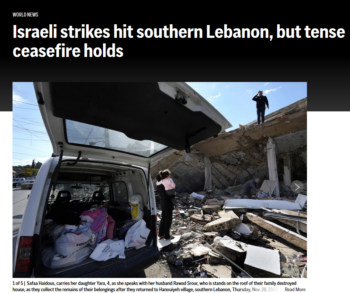
AP (12/1/24) declares that “a tense ceasefire holds,” following the corporate media rule that violence only counts when it’s directed against Israelis.
Israel and Hezbollah signed a ceasefire agreement at the end of November that required both sides to refrain from attacks on each other. The terms also included a mutual pullback from southern Lebanon after 60 days.
Despite the deal, Israel has subsequently launched repeated strikes on Lebanon against targets it claimed were Hezbollah, killing hundreds of Lebanese civilians. The violations began immediately, with Israel attacking journalists and vehicles mere hours after the deal was signed.
Within a week of signing the deal, the UN Interim Force in Lebanon (UNIFIL) reported that Israel had violated the ceasefire around 100 times, killing 15 people. Shortly after these initial strikes, Hezbollah launched two strikes into the disputed border zone that it called an “initial defensive and warning response” to Israel against continued ceasefire violations. These strikes did not kill or injure any Israelis. Despite this, Israel responded by continuing its ceasefire violations, killing more and more, bringing the post-ceasefire death toll to more than 30.
Despite the overwhelming number of Israeli attacks in the post-ceasefire period, news audiences have heard that a “tense ceasefire holds” (AP, 12/1/24). Media repeatedly reported on these violations as both sides “trading” or “exchanging” fire (New York Times, 12/2/24; AP, 12/3/24; NBC, 12/3/24; Semafor, 12/4/24; Financial Times, 12/3/24; Wall Street Journal, 12/3/24). While technically accurate, such reporting frames both sides as equally culpable in violating the ceasefire, allowing media to avoid acknowledging that Israel that Israel is by far the primary and more consistent violator.
Defending violations
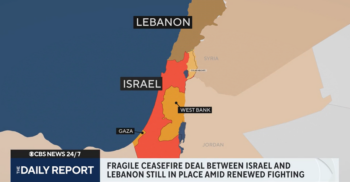
CBS‘s featured guest (12/3/24) insisted that attacks on Lebanon were just Israel “do[ing] what has to get done.”
Other media went further, fully defending rather than just downplaying Israel’s ceasefire violations. CBS (12/3/24) uncritically reported Israel’s justification for its part of the “back-and-forth violence,” telling audiences that the strikes were on “sites that had been used to smuggle weapons from Syria into Lebanon after the ceasefire agreement.” CBS said Israel’s claims about weapon smuggling “rais[ed] questions about whether the reprieve is really an opportunity for Hezbollah and its allies to regroup,” implying that Israel was justified in preventing such a possibility.
CBS‘s guest was Matthew Levitt, a fellow at the hawkish, pro-Israel Washington Institute. He framed the ceasefire as entirely one-sided, suggesting that Hezbollah was unlikely to abide by the ceasefire agreement and that therefore Israel “would enforce this in their own way,” again implying that that would be justified, rather than being itself a violation of the ceasefire.
“This is the post–October 7 world for Israel,” Matthew Levitt told CBS. “They’re not waiting for anybody else to do what has to get done.”
The New York Times (12/3/24) explained away the one-sided violations in a story headlined “Why Israel and Hezbollah Are Still Firing Amid a Ceasefire.” The subtitle read:
Some violations of the truce, and some amount of violence, are to be expected, analysts say, and do not necessarily mean the deal will collapse and war will resume anytime soon.
The Times stumbled over itself to justify Israel’s attacks, writing that “the Israeli military said it had carried out strikes to enforce ceasefire violations.” It did not attempt to explain what it means to “enforce” a “violation.”
‘Exchanged strikes and accusations’
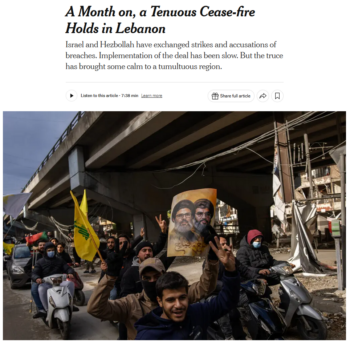
“A Tenuous Ceasefire Holds” is how the New York Times (12/27/24) described Israeli attacks that have killed 30 Lebanese people.
Since these initial reports, the “both sides” framing has continued. A month into the truce, the subhead of a New York Times article (12/27/24) read, “Israel and Hezbollah have exchanged strikes and accusations of breaches,” despite the body of the text overwhelmingly detailing Israeli, not Hezbollah, attacks. The Times described Israel’s “series of strikes” and “extensive operations in dozens of villages.”
The Times implicitly justified the airstrikes by saying that “most of them” were on “Hezbollah’s stronghold in south Lebanon.” As FAIR (11/9/24) has written, referring to urban neighborhoods as “strongholds” is an effective way to prepare audiences for attacks on civilians.
The Times also justified Israeli attacks on Lebanese villages during the ceasefire by uncritically repeating Israel’s stated justification that the IDF “was dismantling tunnels, confiscating weapons and surveillance systems and demolishing a Hezbollah command center.”
‘Cover for continued aggression’
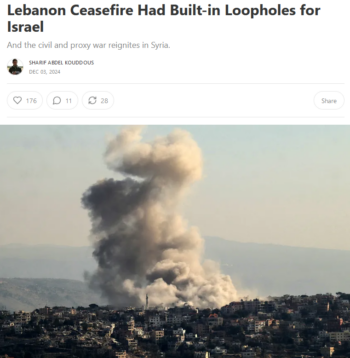
Drop Site (12/4/24): “The framing of the deal…essentially allow[s] for Israel to continue its military assaults while demanding Hezbollah cease all its operations.”
Israel’s continued aggression despite the ceasefire is not surprising. The country has a long history of violating ceasefires while playing the victim. In this conflict, Israel’s violation was anticipated by all sides. Before the deal was inked, Israel signaled its intention to violate the ceasefire by demanding the “right to strike” freedom of action in the event of a ceasefire. The Jerusalem Post (12/1/24) reported that “sources hinted that under certain conditions, the IDF’s presence in southern Lebanon might extend beyond 60 days.” The US assured Israel that they would support Israel in this scenario (Antiwar.com, 11/27/24).
Maryam Jamishidi, an international law expert at Colorado Law School, told Drop Site (12/4/24):
It basically gives Israel very wide latitude to do what it wants, while completely restricting Hezbollah’s ability to act…. Israel likes to use negotiations, likes to use diplomacy, as cover for continued aggression and continued violations of law. And I think this is probably one of the most egregious, because it is framed as a ceasefire agreement.
The media silence makes it easier for US officials to deny reality while continuing to pay for Israel’s military aggression. Despite Israel’s continued violations, Secretary of State Antony Blinken has claimed that the ceasefire is holding. State Department spokesperson Vedant Patel affirmed Israel’s right to defend itself under the ceasefire, but when asked about that same right for Lebanon, he demurred, saying he would not go “down a slippery slope of hypotheticals,” and that “these situations are not totally comparable.”
‘We have to conquer and destroy’
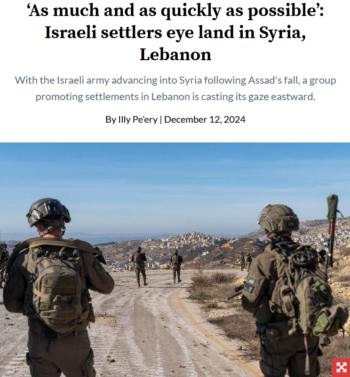
“We have to fight the taboo of the border that was established by France and England 100 years ago,” a settler leader told +972 (12/12/24). “We have to settle everywhere.”
Israelis are exploiting the lopsided ceasefire to create facts on the ground that will be difficult to reverse. As the IDF continues to raze villages and advance into the buffer zone, Israelis are setting up camps in preparation for future settlement.
Israeli Magazine +972 (12/12/24) reviewed the Whatsapp chats of an Israeli group founded to advocate settlement in Southern Lebanon. One member of the group made their goals clear: “We have to conquer and destroy. As much as possible, and as quickly as possible.”
A member of the Israeli settler movement for Lebanon explained to Haaretz (1/2/25) that this has been a longstanding goal for the movement: “Everything we know now we also knew before the war—that this is our land…. We don’t need to apologize.” Such sentiments rarely appear in media aimed at US audiences.
The “both sides” framing is allowing Israel to muddy the waters, and justify its presence in southern Lebanon. Israel is now openly threatening to stay past its 60-day deadline, claiming that Israel will be “forced to act” against Hezbollah for supposedly not fulfilling the ceasefire’s requirements. Despite overwhelming Israeli violations, the pro-Israel media bias obscures who is responsible for continued fighting.
This post was originally published on FAIR.